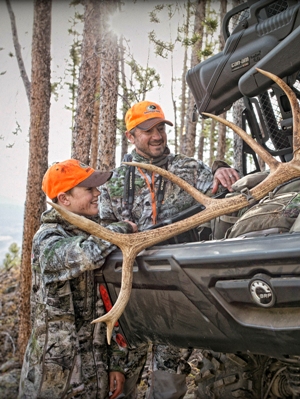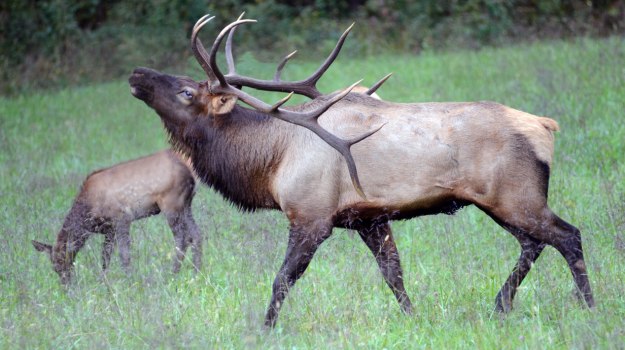Once I have my base camp set up, my hunting party and I will get up at 4 a.m., saddle up our horses, cook a good breakfast and pack our lunches. We want to be on a trail to move farther into elk country by at least 1 to 1-1/2-hours before sunrise. We usually ride from 2 to 5 miles out from base camp before we start hunting. We make it a point to set up our base camp in a really-good area to see elk. Then we don’t have to travel too far from camp to start hunting. Many times we've been able to walk right out of camp and take an elk. Because I've been hunting the same areas for 25 years, I usually know where I'm going to put my base camp before I leave home.
However, when I first started hunting elk on horseback, I had two different types of people that I’d talk to when I would hunt a new region. I’d try to talk to guides and outfitters who were doing summer pack trips and fishing trips into the wilderness areas where I planned to hunt elk during the early season. Usually, they'd tell me where they had seen elk on their trips in and out of the back country. The second kind of person I’d seek information from would be conservation officers and biologists from the fish and game departments. They went into the back country each spring and summer to clear trails and do other land stewardship work. I found these conservation officers and biologists to be very friendly, and they usually would tell me about the animals they’d seen and what was happening as far as the elk herd was concerned in the back country that I planned to hunt in August.
 After talking to these two groups of people, I’d usually get some type of map of the unit I was on hunting, and try to pinpoint the places that looked the wildest and most rugged where few if any hunters would go. Even today, when I'm looking for a place to set-up my base camp, my number-one consideration is to find a remote site where I can have a great outdoor experience, spot plenty of wildlife, see beautiful mountainous terrain and run into few or no other hunters. If I get blessed with the opportunity to put an elk on the ground, that’s fantastic. But if not, I want to have a great outdoor experience, be well off the beaten path and enjoy my surroundings. Because bowhunting for elk is spread out over 30 to 90 days in most states, everyone has plenty of days to hunt. Due to so much public land and plenty of days to hunt, I rarely will ever see other hunters.
After talking to these two groups of people, I’d usually get some type of map of the unit I was on hunting, and try to pinpoint the places that looked the wildest and most rugged where few if any hunters would go. Even today, when I'm looking for a place to set-up my base camp, my number-one consideration is to find a remote site where I can have a great outdoor experience, spot plenty of wildlife, see beautiful mountainous terrain and run into few or no other hunters. If I get blessed with the opportunity to put an elk on the ground, that’s fantastic. But if not, I want to have a great outdoor experience, be well off the beaten path and enjoy my surroundings. Because bowhunting for elk is spread out over 30 to 90 days in most states, everyone has plenty of days to hunt. Due to so much public land and plenty of days to hunt, I rarely will ever see other hunters.
One of my favorite places to hunt is northwest Wyoming, because some units there are open during the rut in September and October, and you can hunt with a firearm or with a bow. One of my favorite places to hunt in northwest Wyoming is in the Shoshone National Forest. I usually go up to a ranch that one of my friends owns where we keep our stock. The friends I'm hunting with will show-up at the ranch the night before the hunt begins the next morning. We’ll load up all our animals and drive to the trail head. Then we’ll mount up and start riding into the mountains. For me, there is no better experience than riding a horse on an Indian Summer day when the leaves are beginning to turn gold and red and ride through and up wide open meadows, high timber country and big mountains. We try to arrive at the place where we’re going to be setting-up our base camp at 4:00 to 5:00 pm in the afternoon. Then we can get our horses and mules picketed, set-up our camp and get ready for a good meal around the campfire. We usually try to get in bed by 10:00 pm. Then we can get up at 4:00 am and are ready to go by 5:00 am.
Since we’re hunting public lands, we don’t know if we’ll see a 350-plus bull elk or a smaller raghorn elk. There are no guarantees. One of the reasons I like to ride a horse when I'm hunting elk is I can cover a lot of country and increase my odds for seeing a nice bull. One time about 4:00 pm, I tied up my horse and ate a late lunch. I took my binoculars out to start glassing. I spotted a nice bull about a mile away, feeding toward where I was eating lunch. I left the horse tied up, put a stalk on that elk and made a clean shot on him. By the time I got to him and field dressed him, dark had fallen. I knew that I’d be better off to leave the elk where I had dropped him and come back the next morning with my pack mules. The bull would’ve scored about 300 or 310 on the Boone Crockett scale.
I returned the next morning with my mules and packed him out. Because of the beautiful scenery and wildlife, I had seen, this would have been wonderful hunt, even if I hadn’t taken the elk. But I was blessed to take the bull, and I was really glad I had my mules to help pack him out.
Day 1: Why Karl Badger Hunts Elk on Horseback
Tomorrow: How to Conduct a Remote Bow Bull Elk




























